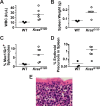Oncogenic Kras initiates leukemia in hematopoietic stem cells
- PMID: 19296721
- PMCID: PMC2656550
- DOI: 10.1371/journal.pbio.1000059
Oncogenic Kras initiates leukemia in hematopoietic stem cells
Abstract
How oncogenes modulate the self-renewal properties of cancer-initiating cells is incompletely understood. Activating KRAS and NRAS mutations are among the most common oncogenic lesions detected in human cancer, and occur in myeloproliferative disorders (MPDs) and leukemias. We investigated the effects of expressing oncogenic Kras(G12D) from its endogenous locus on the proliferation and tumor-initiating properties of murine hematopoietic stem and progenitor cells. MPD could be initiated by Kras(G12D) expression in a highly restricted population enriched for hematopoietic stem cells (HSCs), but not in common myeloid progenitors. Kras(G12D) HSCs demonstrated a marked in vivo competitive advantage over wild-type cells. Kras(G12D) expression also increased the fraction of proliferating HSCs and reduced the overall size of this compartment. Transplanted Kras(G12D) HSCs efficiently initiated acute T-lineage leukemia/lymphoma, which was associated with secondary Notch1 mutations in thymocytes. We conclude that MPD-initiating activity is restricted to the HSC compartment in Kras(G12D) mice, and that distinct self-renewing populations with cooperating mutations emerge during cancer progression.
Conflict of interest statement
Competing interests. The authors have declared that no competing interests exist.
Figures








References
-
- Hanahan D, Weinberg RA. The hallmarks of cancer. Cell. 2000;100:57–70. - PubMed
-
- Dick JE. Acute myeloid leukemia stem cells. Ann N Y Acad Sci. 2005;1044:1–5. - PubMed
-
- Krivtsov AV, Twomey D, Feng Z, Stubbs MC, Wang Y, et al. Transformation from committed progenitor to leukaemia stem cell initiated by MLL-AF9. Nature. 2006;442:818–822. - PubMed
-
- Passegue E, Wagner EF, Weissman IL. JunB deficiency leads to a myeloproliferative disorder arising from hematopoietic stem cells. Cell. 2004;119:431–443. - PubMed
Publication types
MeSH terms
Substances
Grants and funding
LinkOut - more resources
Full Text Sources
Medical
Molecular Biology Databases
Miscellaneous

